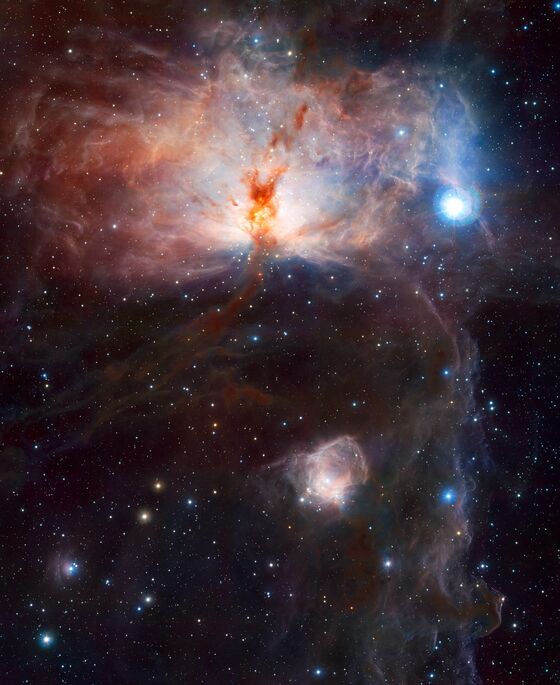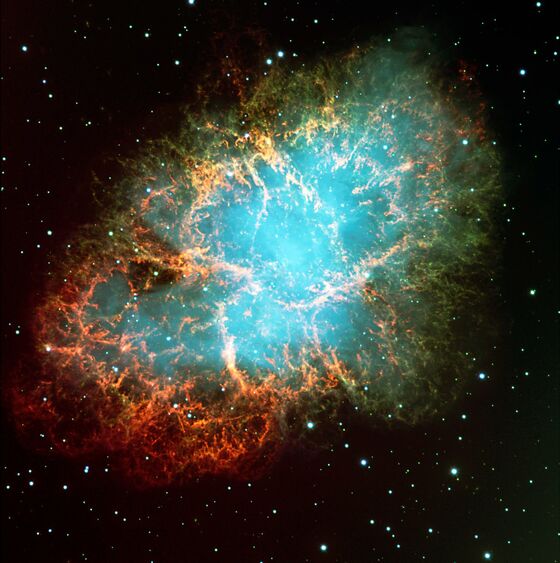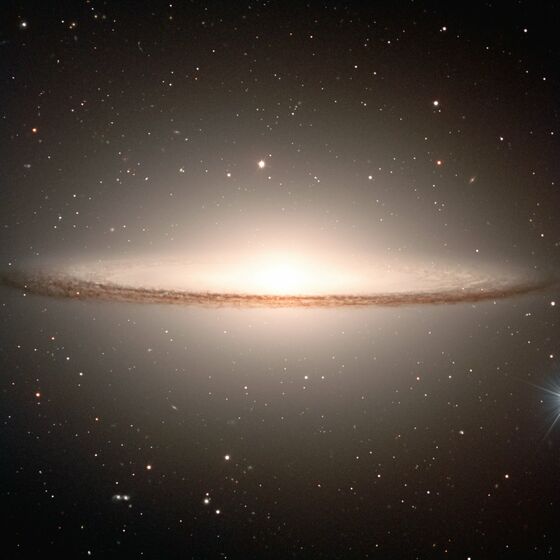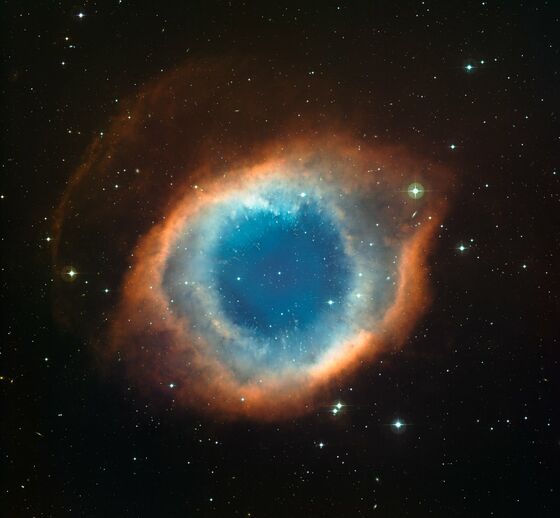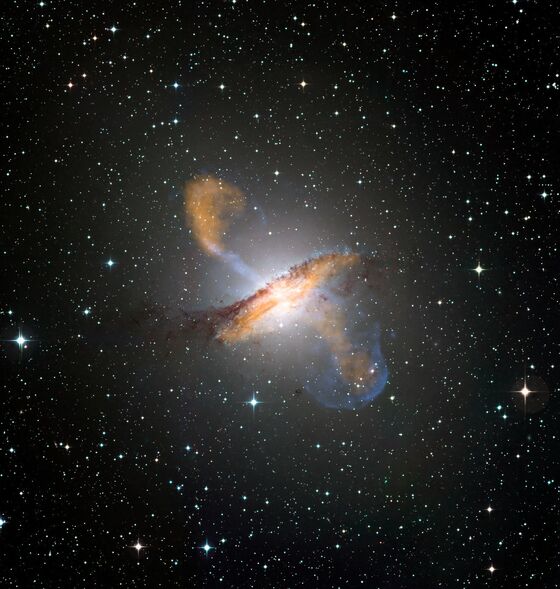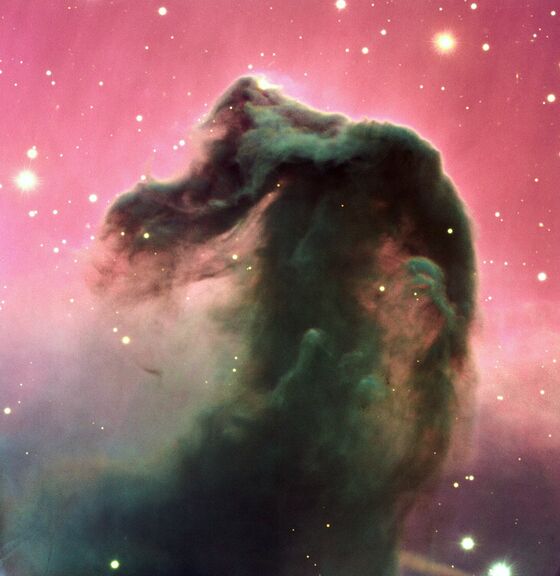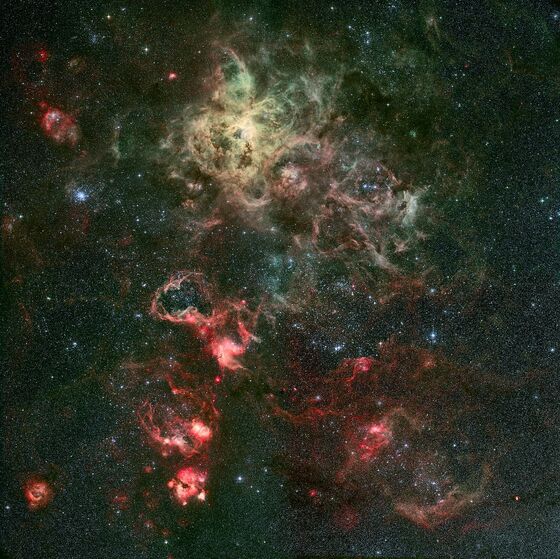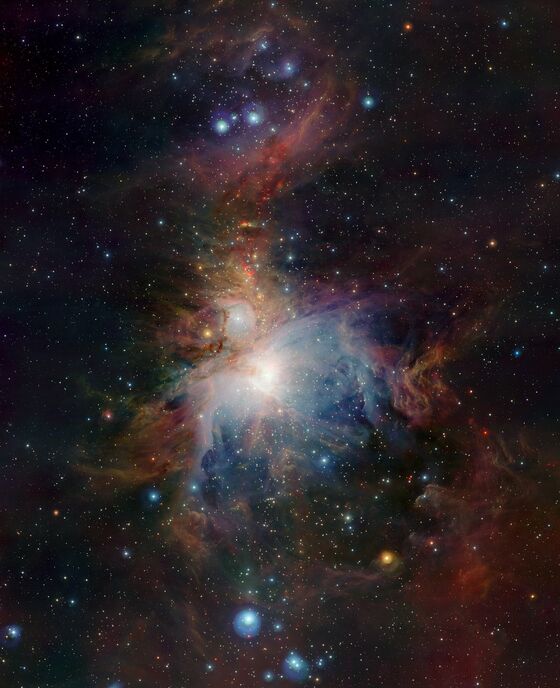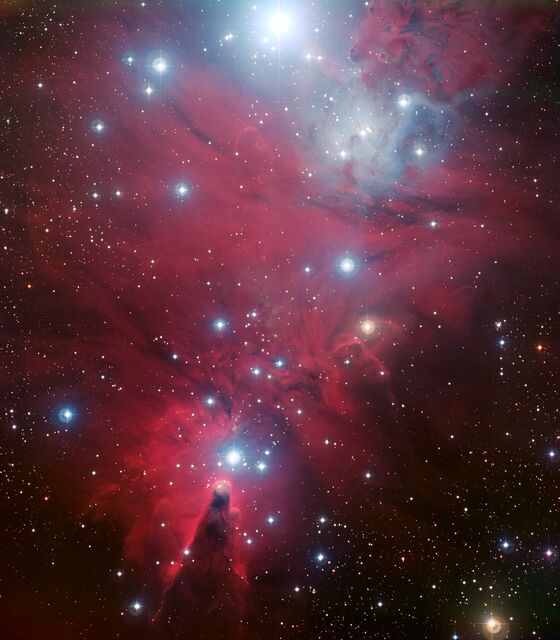In the corridor at the first floor of Vattenhallen you can see pictures from our Universe.
Nebula in the constellation of Orion
This VISTA (the Visible and Infrared Survey Telescope for Astronomy) image shows the spectacular star-forming region known as the Flame Nebula, or NGC 2024, in the constellation of Orion (the Hunter) and its surroundings.
In views of this evocative object in visible light the core of the nebula is completely hidden behind obscuring dust, but in this VISTA view, taken in infrared light, the cluster of very young stars at the object’s heart is revealed.
The wide-field VISTA view also includes the glow of the reflection nebula NGC 2023, just below centre, and the ghostly outline of the Horsehead Nebula (Barnard 33) towards the lower right. The bright bluish star towards the right is one of the three bright stars forming the Belt of Orion.
The image was created from VISTA images taken through J, H and Ks filters in the near-infrared part of the spectrum. The image shows the full area of the VISTA field and is one degree by 1.5 degrees in extent. The total exposure time was 14 minutes.
Credit: ESO | J. Emerson | VISTA. Acknowledgment: Cambridge Astronomical Survey Unit.
The Crab Nebula in Taurus
This photo shows a three colour composite of the well-known Crab Nebula (also known as Messier 1), as observed with the FORS2 instrument in imaging mode in the morning of November 10, 1999. It is the remnant of a supernova explosion at a distance of about 6,000 light-years, observed almost 1,000 years ago, in the year 1054. It contains a neutron star near its centre that spins 30 times per second around its axis (see below).
In this picture, the green light is predominantly produced by hydrogen emission from material ejected by the star that exploded. The blue light is predominantly emitted by very high-energy ("relativistic") electrons that spiral in a large-scale magnetic field (so-called synchrotron emission).
It is believed that these electrons are continuously accelerated and ejected by the rapidly spinning neutron star, at the centre of the nebula and which is the remnant core of the exploded star. This pulsar has been identified with the lower/right of the two close stars near the geometric centre of the nebula, immediately left of the small arc-like feature.
Credit: ESO.
Fine Shades of a Sombrero
Image of the famous early-type spiral galaxy Messier 104, widely known as the "Sombrero" (the Mexican hat) because of its particular shape. The "Sombrero" is located in the constellation Virgo (The Virgin), at a distance of about 50 million light-years.
Messier 104 is the 104th object in the famous catalogue of nebulae by French astronomer Charles Messier (1730 - 1817). It was not included in the first two editions (with 45 objects in 1774; 103 in 1781), but Messier soon thereafter added it by hand in his personal copy as a "very faint nebula". The recession velocity, about 1000 km/sec, was first measured by American astronomer Vesto M. Slipher at the Lowell Observatory in 1912; he was also the first to detect the galaxy's rotation.
This galaxy is notable for its dominant nuclear bulge, composed primarily of mature stars, and its nearly edge-on disc composed of stars, gas, and intricately structured dust. The complexity of this dust, and the high resolution of this image, is most apparent directly in front of the bright nucleus, but is also very evident as dark absorbing lanes throughout the disc. A significant fraction of the galaxy disc is even visible on the far side of the source, despite its massive bulge.
A large number of small and slightly diffuse sources can be seen as a swarm in the halo of Messier 104. Most of these are globular clusters, similar to those found in our own Galaxy.
This picture was obtained with FORS1 multi-mode instrument at VLT ANTU on January 30, 2000. It is a composite of three exposures in different wavebands. North is up and East is left.
Credit: ESO | P. Barthel. Acknowledgments: Mark Neeser (Kapteyn Institute, Groningen) and Richard Hook (ST/ECF, Garching, Germany)
The Helix Nebula
This colour-composite image of the Helix Nebula (NGC 7293) was created from images obtained using the Wide Field Imager (WFI), an astronomical camera attached to the 2.2-metre Max-Planck Society/ESO telescope at the La Silla observatory in Chile.
The blue-green glow in the centre of the Helix comes from oxygen atoms shining under effects of the intense ultraviolet radiation of the 120 000 degree Celsius central star and the hot gas. Further out from the star and beyond the ring of knots, the red colour from hydrogen and nitrogen is more prominent. A careful look at the central part of this object reveals not only the knots, but also many remote galaxies seen right through the thinly spread glowing gas.
This image was created from images through blue, green and red filters and the total exposure times were 12 minutes, 9 minutes and 7 minutes respectively.
Credit: ESO.
Centaurus A
Centaurus A is our nearest giant galaxy, at a distance of about 13 million light-years in the southern constellation of Centaurus. It is an elliptical galaxy, currently merging with a companion spiral galaxy, resulting in areas of intense star formation and making it one of the most spectacular objects in the sky. Centaurus A hosts a very active and highly luminous central region, caused by the presence of a supermassive black hole and is the source of strong radio and X-ray emission.
In the image, we see the dust ring encircling the giant galaxy, and the fast-moving radio jets ejected from the galaxy centre, signatures of the supermassive black hole at the heart of Centaurus A. In submillimetre light, we see not only the heat glow from the central dust disc, but also the emission from the central radio source and – for the first time in the submillimetre – the inner radio lobes north and south of the disc. Measurements of this emission, which occurs when fast-moving electrons spiral around the lines of a magnetic field, reveal that the material in the jet is traveling at approximately half the speed of light. In the X-ray emission, we see the jets emerging from the centre of Centaurus A and, to the lower right of the galaxy, the glow where the expanding lobe collides with the surrounding gas, creating a shockwave.
Colour composite image of Centaurus A, revealing the lobes and jets emanating from the active galaxy’s central black hole. This is a composite of images obtained with three instruments, operating at very different wavelengths. The 870-micron submillimetre data, from LABOCA on APEX, are shown in orange. X-ray data from the Chandra X-ray Observatory are shown in blue. Visible light data from the Wide Field Imager (WFI) on the MPG/ESO 2.2 m telescope located at La Silla, Chile, show the stars and the galaxy’s characteristic dust lane in close to "true colour".
Credits: ESO | WFI (Optical); MPIfR | ESO | APEX | A.Weiss et al. (Submillimetre); NASA | CXC | CfA | R.Kraft et al. (X-ray)
The Horsehead Nebula
Horsehead Nebula is situated in the Orion molecular cloud complex and it is a dust protrusion in the southern region of the dense dust cloud Lynds 1630, on the edge of the HII region IC 434 . The distance to the region is about 1400 light-years (430 pc).
The blue-green regions of the Horsehead Nebula correspond to regions not shadowed from the light from the stars in the H II region to the top of the picture and scatter stellar radiation towards the observer; these are thus `mountains' of dust . The Horse's `mane' is an area in which there is less dust along the line-of-sight and the background (H-alpha) emission from ionized hydrogen atoms can be seen through the foreground dust.
A reproduction of a composite colour image of the Horsehead Nebula and its immediate surroundings. It is based on three exposures in the visual part of the spectrum with the FORS2 multi-mode instrument at the 8.2-m KUEYEN telescope at Paranal. It was produced from three images, obtained on February 1, 2000, with the FORS2 multi-mode instrument at the 8.2-m KUEYEN Unit Telescope and extracted from the VLT Science Archive Facility . The frames were obtained in the B-band (600 sec exposure; wavelength 429 nm; FWHM 88 nm; here rendered as blue), V-band (300 sec; 554 nm; 112 nm; green) and R-band (120 sec; 655 nm; 165 nm; red). The original pixel size is 0.2 arcsec. The photo shows the full field recorded in all three colours, approximately 6.5 x 6.7 arcmin 2 . The seeing was about 0.75 arcsec.
Credit: ESO.
The Magellanic Clouds -The Tarantula Nebula
Known as the Tarantula Nebula for its spidery appearance, the 30 Doradus complex is a monstrous stellar factory. It is the largest emission nebula in the sky, and can be seen far down in the southern sky at a distance of about 170,000 light-years, in the southern constellation Dorado (The Swordfish or the Goldfish). It is part of one of the Milky Way's neighboring galaxies, the Large Magellanic Cloud.
The Tarantula Nebula is thought to contain more than half a million times the mass of the Sun in gas and this vast, blazing labyrinth hosts some of the most massive stars known. The nebula owes its name to the arrangement of its brightest patches of nebulosity, that somewhat resemble the legs of a spider. They extend from a central 'body' where a cluster of hot stars illuminates and shapes the nebula. This name, of the biggest spiders on the Earth, is also very fitting in view of the gigantic proportions of the celestial nebula - it measures nearly 1,000 light-years across. If it were in our own Galaxy, at the distance of another stellar nursery, the Orion Nebula (1,500 light-years away), it would cover one quarter of the sky and even be visible in daylight.
This picture is one square degree image of the Tarantula Nebula and its surroundings. The spidery nebula is seen in the upper-centre of the image. Slightly to the lower-right, a web of filaments harbours the famous supernova SN 1987A. Many other reddish nebulae are visible in the image, as well as a cluster of young stars on the left, known as NGC 2100. Technical information: the image is based on observations carried out by Joao Alves (Calar Alto, Spain), Benoit Vandame and Yuri Beletsky (ESO) with the Wide Field Imager (WFI) at the 2.2-m telescope on La Silla. These data consist of a 2x2 WFI mosaic in the B- and V-bands, and in the H-alpha and [OIII] narrow bands. The data were first processed with the ESO/MVM pipeline by the Advanced Data Products (ADP) group at ESO.
Credit: ESO | R. Fosbury (ST-ECF).
The Orion Nebula - VISTA's infrared view
The Orion Nebula is a vast stellar nursery lying about 1350 light-years from Earth. Although the nebula is spectacular when seen through an ordinary telescope, what can be seen using visible light is only a small part of a cloud of gas in which stars are forming.
Most of the action is deeply embedded in dust clouds and to see what is really happening astronomers need to use telescopes with detectors sensitive to the longer wavelength radiation that can penetrate the dust. Looking to the region above the centre of the picture, curious red features appear that are completely invisible except in the infrared. Many of these are very young stars that are still growing and are seen through the dusty clouds from which they form. These youthful stars eject streams of gas with typical speeds of 700 000 km/hour.
This wide-field view of the Orion Nebula (Messier 42), lying about 1350 light-years from Earth, was taken with the VISTA infrared survey telescope at ESO’s Paranal Observatory in Chile.The new telescope’s huge field of view allows the whole nebula and its surroundings to be imaged in a single picture and its infrared vision also means that it can peer deep into the normally hidden dusty regions and reveal the curious antics of the very active young stars buried there. This image was created from images taken through Z, J and Ks filters in the near-infrared part of the spectrum. The exposure times were ten minutes per filter. The image covers a region of sky about one degree by 1.5 degrees.
Credit: ESO | J. Emerson | VISTA. Acknowledgment: Cambridge Astronomical Survey Unit.
Star formation in NGC2264 -the Christmas tree cluste
NGC 2264 lies about 2600 light-years from Earth in the obscure constellation of Monoceros, the Unicorn, not far from the more familiar figure of Orion, the Hunter. The image shows a region of space about 30 light-years across. The dazzling star at the top is even bright enough to be seen with the unaided eye. It is a massive multiple star system that only emerged from the dust and gas a few million years ago.
At the bottom of the frame, the dark triangular feature is the evocative Cone Nebula, a region of molecular gas flooded by the harsh light of the brightest cluster members. The region to the right of the brightest star has a curious, fur-like texture that has led to the name Fox Fur Nebula.
Much of the image appears red because the huge gas clouds are glowing under the intense ultraviolet light coming from the energetic hot young stars. The stars themselves appear blue as they are hotter, younger and more massive than our own Sun. Some of this blue light is scattered by dust, as can be seen occurring in the upper part of the image. This intriguing region is an ideal laboratory for studying how stars form. The entire area shown here is just a small part of a vast cloud of molecular gas that is in the process of forming the next generation of stars. Besides the feast of objects in this picture there are many interesting objects hidden behind the murk of the nebulosity. In the region between the tip of the Cone Nebula and the brightest star at the top of the picture there are several stellar birthing grounds where young stars are forming. There is even evidence of the intense stellar winds from these youthful embryos blasting out from the hidden stars in the making.
NGC 2264 and the Christmas tree cluster. Credit: ESO.

